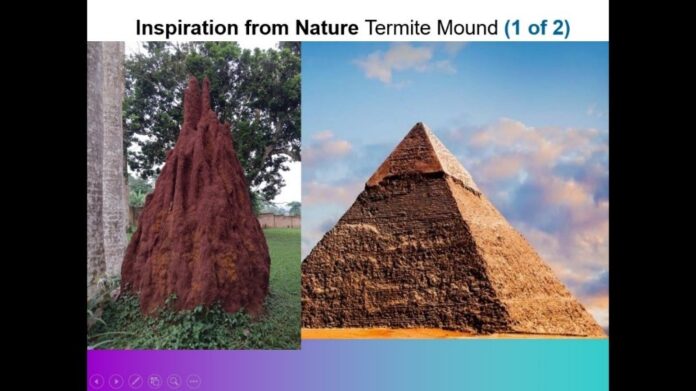
Termite design concept
Good day Ghana. I trust you are keeping safe wherever you find yourself. In keeping with my promise, this week we will share another presentation made at the 3rd Ghana Green Building Summit. Presented under the theme of green indigenous architecture, we explored some of the indigenous building concepts. One of the striking cultural elements of many a society is their building architecture; a personality carved deliberately with indigenous material, colour, motifs and other symbolic accents. Until the influence of western design, indigenous design leveraged the immediate natural environment to provide quality indoor air, cooling and other functional spaces. In our quest for healthier and functional spaces, we re-opened this much needed conversation on indigenous architecture with the question: Is a Green Indigenous Architecture Attainable?
Ben Adarkwa, RIBA – Architect and Partner, Benson Architects answered in the affirmative and he proceeded to use the termite mound concept to back his answer by highlighting 3 areas of interest.
Kindly find below Ben Adarkwa’s presentation and do feedback if you have any experience in the adoption of indigenous architecture.
Termite Mound Inspiration
- The mound is built out of a mixture of clay, termites’ saliva and dung. It is known to have better thermal resistance properties (called U-value) than most building materials.
- The conical shape of the mound offers only half the surface area to sunlight while the other half remained in shade. This condition reverses between the mornings and evenings to ensure minimum heat transfer into the mound.
This is the most appropriate architectural form for the tropical environment and resonate with the Egyptian pyramids which is one of the defining architectural achievements of the ancient world.
- The 3rd wonder of these creatures is their ability to sense, and harness the drop in night temperature to regulate internal temperatures. Through the use of thermal imagery cameras and heat sensors, they are observed to open the holes to allow cool night air to flush the mound and remove stale air. During the daytime, they plug the holes back leaving only the central tunnel to the top, to provide stack effect for the mound.
Another example, is a traditional English barn. The question is whether this type of building, appropriate for temperate zone, is also appropriate for the tropical Africa?
The answer is ‘Yes’ for a different reasons. The high pitch roof is meant to ward off snow loading in attic weather but same can be used in tropical regions to combat solar heat gain, similar to the termite mound. Besides, when the sun is directly above the roof, the angle of incident is less than 90o degrees to the pitch roof which helps to deflect the sunlight and reduce heat gain, unlike flat roofs.
- The traditional English barn was successfully adapted by the missionaries during the colonial period with additional features like verandas and deep canopies to shade the walls from sunlight.
- The walls are made of mud, up to a metre thick to provide good heat resistance (u-value) and helps keeps the inside cool.
- Many of such examples are dotted round the country. It was the same building style used as residence, hospitals and training institutions as in the case of Ramseyer training centre at Abetifi, the Ridge Hospital etc. However, most of these tried, tested and successful building types are neglected, are in ruins and making way for monstrosities like the National Cathedral being built.
- They are the correct building type for the tropics and are national treasures that must be preserved for future generation to learn from.
Another example is the ‘Eastgate Shopping Centre’ at Harare. Worth mentioning not because of the form but because it is a modern attempt to mimic the termite method of flushing the interior with cool night air, using mechanical ventilation. Thereby, reducing the cost of cooling by some 90% and passing on the saving to tenants who in turn pass it onto customers. It is a good effort but 10% energy usage through mechanical ventilation exceed our target of zero %. The form suggest temperate zone building type which might be justified, because of the elevated altitude of Harare, which enjoy temperate conditions, despite being in tropical zone. However, this form will not be advisable in any other tropical environment for good reasons.
Sustainable, Affordable and ‘Self-cooling’ Homes
Our proposal is the Sustainable, Affordable and ‘Self-cooling’ Homes, (SASCH for short). The design concept is based on the true termites tradition using natural ventilation to achieve cooling and no air-condition required.
‘Self-cooling’ is a relatively new concept applicable only to termite mounds but for the first time would be applicable to human habitat, because the secret of the shy creatures has been uncovered and can be adapted to suit our present needs without compromising that of future generation and that is true sustainability
To unpack this proposal, let’s examine the elements:
- The high pitch roof and overhangs helps to combat the overheating of the interior and also allows bedrooms to be concealed in the loft spaces. Implying that walls are not exposed to sunlight with the added bonus of only one side plastered and painted while the other side is left fare face, saving up on cost for affordability.
- The use of environmentally friendly materials, clay bricks and clay roofing tiles backed up by modern cavity wall construction would increase the ‘lag time’ and delay heat transfer to the inside, which is key to keeping the building cool.
- The natural ventilation rely on the buoyancy of hot air to rise. During the day the heated roof draws air upwards through the ducts and loft spaces and escape through the roof vent, forcing internal air circulation and producing the ‘stack effect’.
- At night the reverse happens when temperatures drop. Adjustable louvres in the bedroom balcony walls can be opened to flush the spaces below with cool night air and shut during the daytime to keep the coolness inside same as the termites do.
Besides the termite cooling concept, other measures are taken into consideration to ensure it satisfies ‘Green Building’ standards such as the BRE Code for Sustainable Homes, these include:
- Minimum footprint to free up the site to allow vegetation to reduce heating from sunlight. In addition we get ‘Sustainable Urban Drainage System’ (called SUDS) requirements fulfilled. This allows deep rainfall penetration into the ground to avoid run-offs turning into floods.
- Rainwater is harvested from the roof and stored in water a tank attached to the living area. This ensures that the cooling property of water is added to minimise temperature swings inside the building.
- Notice how the French windows are recessed deep into the canopies to avoid sunlight on the glass to keep out the ‘greenhouse effect’.
- Incidentally, we discovered a termite mound under the SASCH Pilot scheme and decided, for sound ecological reasons, to work around it, allowing the two buildings to co-exist by turning, twisting and scaling down the SASCH building to fit.
Proper detailing ensure longevity and keeping the coolness inside.
The thickness of the cavity walls plus insulation can be adjusted to affect the ‘lag time’ to suit any geographical condition. Thus, if we can achieve a ‘lag time’ between 8-10 hours anywhere, it will be sufficient delay to enter into the next cycle of cool night air to induce perpetual cooling effect in the building throughout the year
It is anticipated that inside temperatures would range from 5o C to 10o C below normal outside temperatures depending on where you live. For example in Aburi where average night temperatures are around 22 degree C and daytime temperatures 32-36 degree, up to 10o C cooler inside is possible. In Accra where night temperatures averages around 26 degree C, while daytime is around 32 degree C. It would be possible to achieve 6o C below normal temperatures. These figures will be even more favourable in the northern regions, where day and night temperature swings is higher.
It is hoped this SASCH Project would form the basis of ‘Green Indigenous Architecture’ with zero carbon footprint
PRESENTED BY BEN ADARKWA, RIBA – ARCHITECT AND PARTNER, BENSON ARCHITECTS AT THE 3RD GHANA GREEN BUILDING SUMMIT









